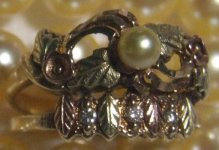Pearl Dreams
Pearl Enthusiast
Caitlin has made an excellent post.
I grew up loving the look and idea of pearls. I very much desired to one day own a strand of cultured pearls. Then in the 1970s I read an article on pearls in National Geographic which discussed the problems associated with the thinner nacre Akoya pearls that were increasingly being sold and the resulting decrease in durability that could be expected. This dismayed me, and I decided an Akoya strand was not a good value for me. I bought Majorica imitation pearls instead for my wedding.
With more knowledge now under my belt, I realize there is a wide range of quality available and that pearls with good nacre thickness can be purchased-- and that Tahitians/ SSP have greater nacre thickness than Akoyas. But somehow, given the fact that there is a huge honking bead in there, I still have a hard time thinking of them as "real" pearls. Even though the world now accepts them as real pearls, for me they are less real than the ones that are essentially nacre all the way through.
I do own natural color [baroque] Akoyas, so I'm not saying I would never buy bead nucleated pearls-- but I have a strong bias toward all-nacre pearls. And toward the more affordable pearls, since my discretionary funds are limited, and I enjoy buying other luxury items besides pearls!
I grew up loving the look and idea of pearls. I very much desired to one day own a strand of cultured pearls. Then in the 1970s I read an article on pearls in National Geographic which discussed the problems associated with the thinner nacre Akoya pearls that were increasingly being sold and the resulting decrease in durability that could be expected. This dismayed me, and I decided an Akoya strand was not a good value for me. I bought Majorica imitation pearls instead for my wedding.
With more knowledge now under my belt, I realize there is a wide range of quality available and that pearls with good nacre thickness can be purchased-- and that Tahitians/ SSP have greater nacre thickness than Akoyas. But somehow, given the fact that there is a huge honking bead in there, I still have a hard time thinking of them as "real" pearls. Even though the world now accepts them as real pearls, for me they are less real than the ones that are essentially nacre all the way through.
I do own natural color [baroque] Akoyas, so I'm not saying I would never buy bead nucleated pearls-- but I have a strong bias toward all-nacre pearls. And toward the more affordable pearls, since my discretionary funds are limited, and I enjoy buying other luxury items besides pearls!
Last edited:

